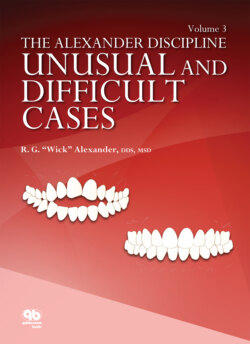Читать книгу The 20 Principles of the Alexander Discipline, Volume 3 - R.G. "Wick" Alexander - Страница 7
На сайте Литреса книга снята с продажи.
ОглавлениеPreface
If an orthodontist or general dentist has very limited education or experience, every case he or she treats can be described as “unusual and difficult.” Every young orthodontist or general dentist can easily select the wrong bracket, choose the wrong archwire, or select and place the wrong orthopedic force. These poor decisions can either have minor effects on the results or be devastating and require severe treatment-planning changes.
As mentioned in Case 9-3 of volume 2, when we are dealing with human beings, we have limitations. Although we can make tremendous improvements in the dentition and facial appearance, some factors for gaining permanent stability in selected patients are out of our control. The skeletal pattern of the patient in that case had deteriorated vertically over time, and her final overbite and overjet after 18 years were greater than they were at the beginning of her first treatment.
For those doctors who are new to the Alexander Discipline, it may seem that our treatment technique is so simple that the doctor can be successful even without learning the fundamentals of orthodontics. Many general practitioners are misled to believe that orthodontics is easy. The reality is that there is no such thing as an “easy” case. The Alexander Discipline is simple if you follow the rules and understand the limitations of each sequence.
The purpose of this book is to demonstrate how certain changes should be made from the “routine” system to adapt to the individual “unusual” case. These changes can include unusual extraction patterns, bracket angulations, treatment timing, and substitution of selected teeth. The most exciting thing about this book is that it demonstrates how “adaptable” the dentoalveolar hard and soft tissues can be under certain conditions. And in several cases we were able to obtain long-term records to demonstrate not only the stability of the occlusion but also the long-term health of the hard and soft tissues.
Hopefully this book can give the reader a new perspective in regard to the treatment of certain malocclusions and the potential stability possible for each.
R. G. “Wick” Alexander
